 Research Article
Research Article
Benefits of Les Mills BODYPUMP® vs YogaFit® Training on Sedentary Adults Age 50 to 70
Terry F Eckmann*, Heather L Golly and Vicki Michels
Department Chair, Teacher Education and Kinesiology, Minot State University, USA
Terry F Eckmann, Department Chair, Teacher Education and Kinesiology, Minot State University, USA.
Received Date: December 27, 2020; Published Date: January 15, 2021
Abstract
As people age the risk of cognitive dysfunction, cardiovascular disease, musculoskeletal disability and injuries from falls greatly increases. Interventions that can help reduce the risk in all four areas can save lives, improve quality of life, and save medical care costs. The purpose of this study was to examine the physical benefits of Les Mills BODYPUMP® vs. YogaFit® training for fifty-five minutes, three days a week for eight weeks on sedentary adults aged 50 to 70. The YogaFit® group consisted of 6 males (59.83+5.63) and 23 females (57.35+ 4.79) while the Les Mills BODYPUMP® group consisted of 6 males (56.33+4.32) and 17 females (57.06+5.528). An ANOVA analysis revealed statistically significant differences in fitness performance scores between the two groups, F (30, 19) = 2.14, p < .05; Wilk’s Λ = 0.228, partial η2 = .77. The results of the Bonferroni post-hoc test, between groups for pre-training and post-training measures are described in Table 1. The results of this study indicate that in a sedentary population, not only does performing exercise improve fitness but the use of the Les Mills BODYPUMP® classes shows significant improvements in strength and flexibility related measures when compared with those who perform YogaFit® training.
Table 1:ANOVA Results M = Mean, Yoga represents YogaFit® Style Training, BP = Les Mills BODYPUMP®, M Y-BP = Mean Difference, SE= Standard Error of the Mean, P = Level of significance.
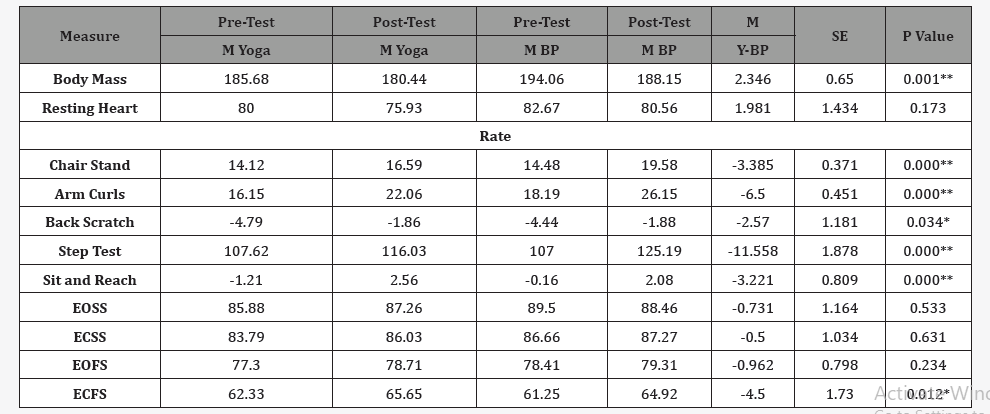
Keywords: Les Mills BODYPUMP®; YogaFit®
Introduction
The population of people over the age of 50 years in the United States is growing rapidly; as people age the risk of cognitive dysfunction, cardiovascular disease, musculoskeletal dysfunction and injuries from falls greatly increases [1]. Interventions that can help reduce the risk in all of the aforementioned areas can potentially save lives, improve life quality, and save medical care costs [2-4]. There are a growing number of studies that explore the effects of different types of exercise on physical and cognitive health and physical fitness. However, there are few studies in the literature that provide a comparison of specific activities on physical and cognitive abilities.
Over the past three decades there has been an increase in type and number of group exercise activities in fitness centers and active aging communities. Les Mills BODYPUMP® and YogaFit® are two popular exercise programs appropriate for the 50 to 70-year-old population. Les Mills BODYPUMP® is a choreographed group strength training class. YogaFit® integrates the practice of yoga and traditional fitness movement in a program designed to increase muscle strength, endurance and flexibility while improving balance.
A review of the literature provides evidence that strength training has many health-related benefits, including decreasing risk to all causes of mortality, fewer cardiovascular events (e.g. heart attack and stroke), improved body composition, better glucose metabolism and insulin sensitivity, and lower blood pressure in persons with prehypertension and hypertension [5]. There are a wide variety of group and individual strength training options. One group strength training exercise program that has grown in popularity is Les Mills BODYPUMP®, a barbell class based on 10 tracks, each focusing on a different muscle group. The claimed benefits of Les Mills BODYPUMP® is improvement in strength and endurance of major muscle groups and an energy expenditure of up to 600 kcals per session. [6] also showed that BodyPump is as effective as heavy load resistance training at burning calories, 300kcal per session. [7] studied the effects of a 12-week Les Mills BODYPUMP® training on neuromuscular fitness and concluded that Les Mills BODYPUMP® training may significantly improve maximal muscle strength of lower limbs. The investigators reported that the training program did not seem to improve aerobic running fitness. [8] studied the chronic responses to Bodymax, a group fitness training using low-intensity exercises with 1 to 5 Kg free weights and barbells and 36 repetitions per set. After 12 weeks on this training regimen, the women increased muscular strength and lowered skinfold thickness.
Pfitzinger [9] studied aerobic consumption and energy expenditure in body pump. The researchers defined body pump as a choreographed strength-training program with low resistance and high repetition to overload the muscles. Results suggested that body pump provides a low stimulus to improve aerobic capacity and should not be used as the only method of cardiovascular exercise. However, the research reported that body pump produces a significant caloric expenditure and may also provide other fitness benefits such as muscular body mass increase and maintenance of body composition. [10] reported that body pump class responses were below that necessary to elicit an aerobic-training effect and were lower than responses previously reported with circuit weight training. These articles did not specify as to whether body pump was the Les Mills BODYPUMP® program.
A review of the literature also supports the health and fitness benefits of yoga. Yoga as an alternative medical therapy is an emerging trend. Fourteen million people in the United States have had a doctor or a therapist suggest yoga as a therapeutic tool and 45% of adults surveyed believe yoga is a beneficial adjunct therapy for traditional medical treatment [11].
A review of yoga research indicated improvement in gait, increase in upper and lower body flexibility, increased lower body strength and weight loss [12]. [13] examined studies comparing effects of yoga and exercise and found yoga to be as effective or better than exercise at improving a variety of health-related outcome levels, including heart rate variability, blood glucose, blood lipids, salivary cortisol, and oxidative stress. Yoga seemed to do better at relieving physical symptoms and perception of stress. Boehde [14] compared subjects who performed an average of about 21 hours of hatha yoga classes with a sedentary control group. At the end of the 8-week study period, the yoga group showed significant improvements in flexibility, balance and muscular endurance compared with the controls. Researchers who examined the fitness-related benefits of hatha yoga studied 10 untrained subjects who had no experience with yoga. The subjects participated in hatha yoga twice a week. After 8 weeks, the subjects showed significant improvements in upper and lower-body muscular strength, endurance and flexibility; there was no statistically significant change in body composition or pulmonary function. Unfortunately, this trial lacked a control group, had a relatively short training period and drew from a small, homogeneous sample [15].
The purpose of this study was to determine effects of YogaFit® and Les Mills BODYPUMP® on muscle strength, endurance and flexibility, cardiovascular endurance, balance, weight loss and body composition of sedentary adults aged 50 to 70. The study results may also help to determine which exercise program, Les Mills BODYPUMP® or YogaFit® may result in greater improvement in muscle fitness, cardiovascular fitness, balance, and body mass in adults aged 50 to 70 years of age.
Methods
Subjects
Experimental Les Mills BODYPUMP® and YogaFit® Sessions: Les Mills BODYPUMP® and YogaFit® classes were offered for fifty-five minutes on five days of the week to make attendance of three classes per week more convenient and accessible to research participants. Only those individuals who met the attendance requirement of attending three sessions a week at least 8 of the 10 weeks were included in the results of this study.
YogaFit® class participants were given the option of executing poses seated in a chair or standing and on the floor on a yoga mat, or a mix of the two. The intensity and complexity of poses from YogaFit® Level 1 and YogaFit® Seniors were used throughout the study. The complexity and intensity were gradually increased over the eight-week period. Participants were encouraged to follow the YogaFit® guideline of honoring yet challenging the body. Two instructors taught each class to provide a high level of modeling, instructional cues, feedback, and consistent observation of alignment. Both instructors had completed YogaFit® Level 1 and YogaFit® Seniors training.
Les Mills BODYPUMP® is the original LES MILLS™ barbell class. The BODYPUMP® formula is the rep effect which focuses on low weight loads and high repetition movements designed to burn fat, gain strength and quickly produce lean body muscle conditioning. The research participants completed modified BODYPUMP® 84 during the eight-week program.
Les Mills BODYPUMP® is an intense workout. Due to the participant’s low level of fitness and the limited skill and experience of the participants, modifications were implemented to ensure safety and program adherence. The modifications applied for all participants included slowing the tempo of the music, reducing the number of sets, reducing the number of tempo changes for the exercises, omission of overhead presses or cleans, and elimination of jump squats during the lunge track. The alternate core track was used. Modifications modeled as an option for BODYPUMP® 84 sessions included using plates only or the bar with no weights for all tracks, using the wall for balance for lunges during the lunge track, and push-ups against the wall instead of on the floor for the shoulders track. Level options were modeled and cued by two instructors during each workout to provide a high level of safety and effectiveness.
Assessment
The population of the United States is living well into their 8th and 9th decades of life and delaying or preventing the onset of physical frailty is an increasingly important goal. Rikli and Jones [16] developed a functional fitness test for communityresiding older adults to provide a means of measuring the key physiological parameters that support functional mobility in older adults. Reliability R = .80 - .95 and validity R =.61 - .82 has been established for all test parameters. The measures that will be used in this study include the chair stand for lower body strength, the arm curl for upper body strength, the 2 minute step in place test to measure aerobic endurance, the chair sit-and-reach for lower body flexibility, the back scratch for upper body flexibility, and the upand- go for agility/dynamic balance [17]. The physical assessments of Rikli and Jones Senior Functional Fitness Test were used due to the level of fitness and age of the population recruited for the study. Three cognitive tests: Stroop Test, Beck’s Depression Inventory and Benton Test were given as a baseline prior to class participation after the eight-week training. The physical assessment results will be addressed in this article.
The chair stand test is similar to a squat test to measure leg strength and endurance. A straight back folding chair without armrests (seat 17 inches/44 cm high) was placed against the wall for safety while the subject completed the chair stands for 30 seconds. The subject was instructed to sit in the middle of the seat, with feet shoulder width apart, flat on the floor. The arms were crossed at the wrists and held close to the chest. The subject stood completely up from the sitting position and then sat completely back down as many times as possible for 30 seconds. This was monitored visually by the investigator who counted the total number of complete chair stands (up and down equals one stand). If the subject completed a full stand from the sitting position when the time was elapsed, the final stand was counted in the total.
The Arm Curl test is a test of upper body strength and endurance. A 5-pound weight was used for women and an 8-pound weight was used for men. The subjects were instructed to do as many arm curls as possible in 30 seconds. This test was conducted on the dominant arm side (or stronger side). The subject sat on the chair without armrests, holding the weight in the hand using a suitcase grip (palm facing towards the body) with the arm in a vertically down position beside the chair. The upper arm was braced against the body so that only the lower arm was moving. The subject curled the arm up through a full range of motion, gradually turning the palm up (flexion with supination). As the arm was lowered through the full range of motion it returned to the starting position. The arm must be fully bent and then fully straightened at the elbow for one arm curl. The investigator visually observed and counted as the subject repeated the action as many times as possible within 30 seconds.
The 2 Minute Step in Place was used to measure aerobic endurance. Tape was used for marking the wall midway between the patella (kneecap) and iliac crest (top of the hip bone) as the subject stood up straight next to the wall. The subject then marched in place for two minutes, lifting the knees to the height of the tape. Resting and holding on to the wall was allowed. The investigator observed and counted the number of steps for two minutes.
The Chair Sit and Reach Test was used to measure lower body flexibility. The subject sat on the edge of a chair (placed against a wall for safety). One foot remained flat on the floor. The other leg was extended forward with the knee straight, heel on the floor, and ankle bent at 90°. One hand was placed on top of the other with tips of the middle fingers even. The subject was instructed to inhale, and then while exhaling, to reach forward toward the toes by bending at the hip with the back straight and head up. The subject was instructed to avoid bouncing or quick movements, and to never stretch to the point of pain. The knee was kept straight and held for 2 seconds. The distance between the tip of the fingertips and the toes was measured. If the fingertips touch the toes, then the score is zero. If they do not touch, the distance between the fingers and the toes was measured as a negative score. If the fingers reach beyond the toes the distance was measured as a positive score. The subject performed two trials and the best of two was documented.
The Back-Scratch Test assesses general shoulder range of motion by measuring how close the hands can be brought together behind the back. This test is done in the standing position. The subject placed one hand behind the head and back over the shoulder while then reaching as far as possible down the middle of their back with the palm touching their body and the fingers directed downwards. The other arm was placed behind the back with the palm facing outward and fingers upward. The subject reached up as far as possible attempting to touch or overlap the middle fingers of both hands. The investigator directed the subject so that the fingers were aligned and measured the distance between the tips of the middle fingers. If the fingertips touched, then the score was zero. If they did not touch, the distance between the fingertips (a negative score) was measured. If they overlapped the amount of the overlap was measured (a positive score).
The Back-Scratch Test assesses general shoulder range of motion by measuring how close the hands can be brought together behind the back. This test is done in the standing position. The subject placed one hand behind the head and back over the shoulder while then reaching as far as possible down the middle of their back with the palm touching their body and the fingers directed downwards. The other arm was placed behind the back with the palm facing outward and fingers upward. The subject reached up as far as possible attempting to touch or overlap the middle fingers of both hands. The investigator directed the subject so that the fingers were aligned and measured the distance between the tips of the middle fingers. If the fingertips touched, then the score was zero. If they did not touch, the distance between the fingertips (a negative score) was measured. If they overlapped the amount of the overlap was measured (a positive score).
The Clinical Test of Sensory Integration of Balance on the Humac Norm Balance System (modified Wii Balance Board) was used to assess the subject’s ability to integrate the vision, vestibular, and somatosensory systems to balance the body. The test was performed by the investigator on a firm surface and a foam surface with eyes open and eyes closed.
Statistical Analyses
Results
Data management: Data was analyzed using IBM® SPSS Statistics version 2.1. The level of significance was set apriori at p < 0.05. A repeated measure MANOVA was used to analyze between group differences as well as a Paired Samples T-Test to analyze within group differences.
Participants were recruited through television, radio, Minot Public School email system, Minot State University campus announcements, and social networking. Fifty-two participants mean age 57.42+5.031 who received medical clearance, completed an informed consent form, and agreed to participate for eight weeks in either YogaFit or Les Mills BodyPump group exercise classes three days a week for fifty-five minutes were assigned to either the YogaFit or Les Mills BodyPump group exercise training. Assignment was based upon personal preference of the participant. Those who did not have a preference were randomly assigned to either group. Because some participants would not participate unless assigned to a particular group, it was decided it was better to have a larger sample size than to maintain strict random assignment. The YogaFit group consisted of 6 males (59.83+5.63) and 23 females (57.35+4.79) while the Les Mills BodyPump group consisted of 6 males (56.33+4.32) and 17 females (57.06+5.528). In order to qualify for the research, participants either did not exercise or exercised sporadically (week on, week off; month on month off; once a week). This study was approved by the Institutional Review Board of Minot State University. Two participants in the Les Mills BodyPump group dropped out of the study and four were sick on the day of the post-test. Two in the YogaFit group dropped out of the study due to their own or family illnesses.
Between Group Results
In order to answer the question as to whether one exercise type was related to greater improvement and whether gender was a factor a three-way MANOVA was used. The three-way interaction was not significant. The results of the MANOVA indicated a significant interaction between groups and pre and post exercise (p=.022). The interaction effects appear to be significant between the groups pre and post tests for arm curls (p = .000), chair (.001); and Wii Humac Balance eyes open sway on a foam surface (p = .034). Compared to the YogaFit group, the Les Mills BodyPump group increased their performance on the chair stand (pre M=14.79 post M=19.58, YogaFit pre M=14.31, post M=16.72) and arm curls (pre M=18.71, post M=26.46, YogaFit pre M=16.66, post M=22.17). The YogaFit group improved more than the Les Mills BodyPump group on the Wii Humac Balance eyes open Sway on a foam surface (pre-M=77.00, post M=78.55, Les Mills Body Pump Pre-M=79.04, post M=79.42.
Within Group Results
Yoga participants showed a significant increase in the number of repetitions performed during the chair stand test (t(32)=-5.937, p<.000), a significant decrease in resting heart rate (t(29)=2.113, p<.043), significant increase in the number of repetitions performed during the arm curl test (t(32)=-11.062, p<.000), and a significant increase in lower body flexibility during the chair sit and reach test (t(32)=--2.771, p<.009). There were no significant changes in body weight and upper body extremity flexibility,
Les Mills BODYPUMP® participants showed a significant increase in the number of repetitions performed during the chair stand test (t(26)=-9.186, p<.000), a significant increase in the number of repetitions performed during the arm curl test (t(26)=-11.551, p<.000), a significant increase in lower extremity flexibility during the chair sit and reach test (t(26)=-6.030, p<.000), a significant increase in upper body flexibility during the back scratch test (t(26)=-2.618, p<.015), and a significant decrease in body weight ((t(26)=2.139, p<.042). There were no significant changes in resting heart rate [Tables 1&2], [Figures 1-8].
Table 2:Pair T-Tests Comparison of Pre-Test and Post-Test Measures of Dependent Variables.
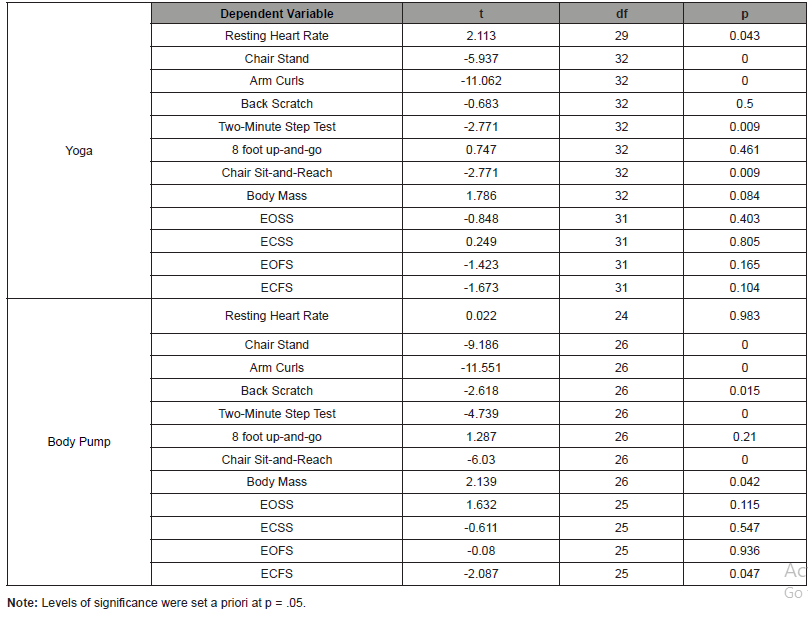
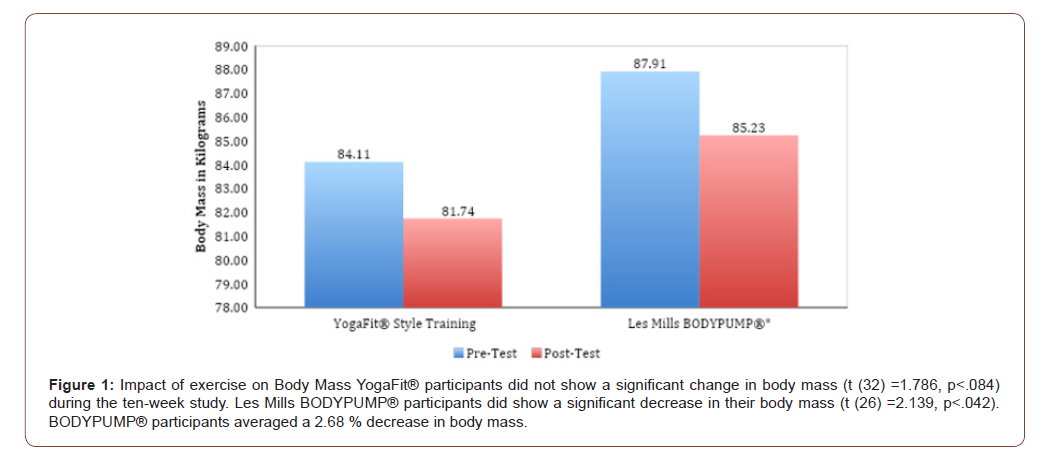
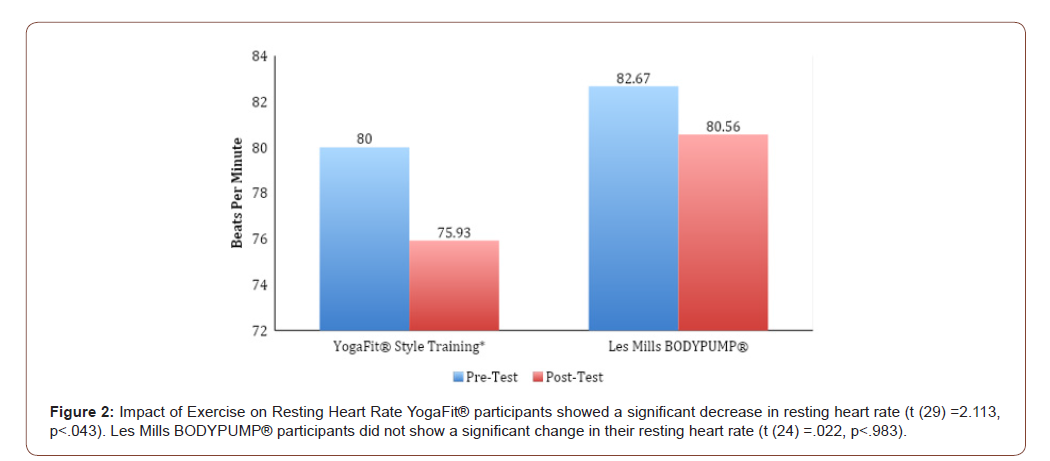
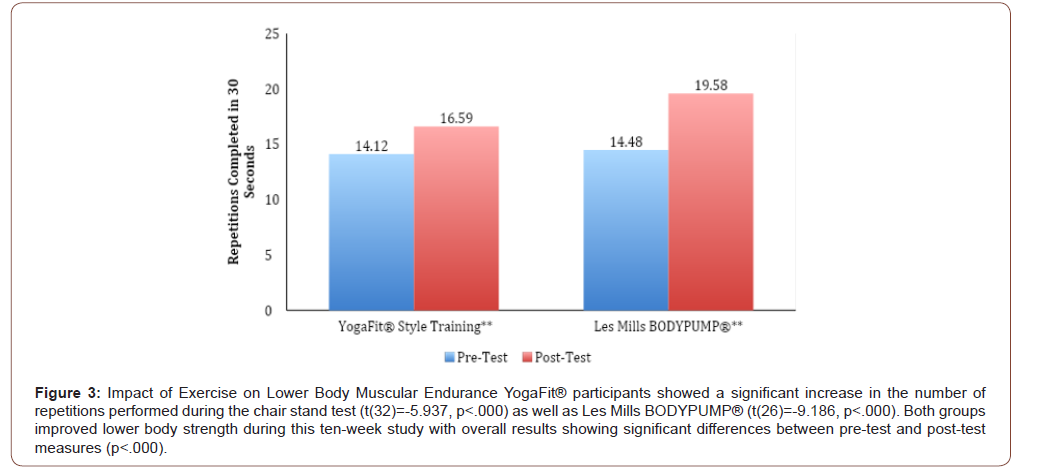

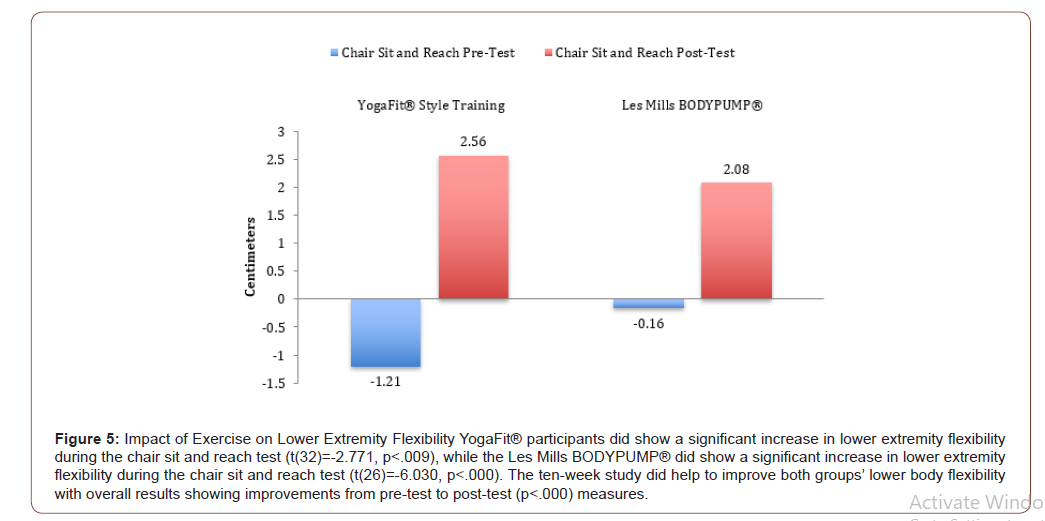
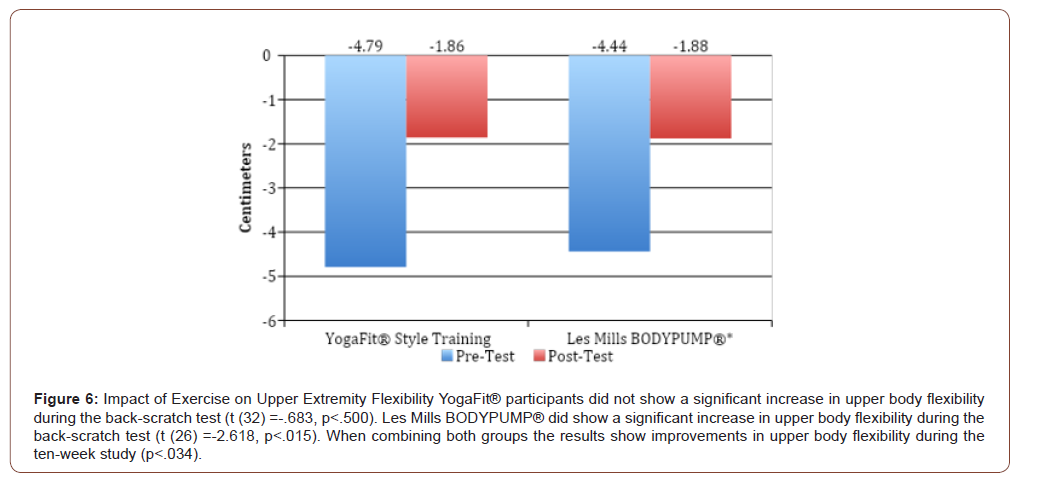
Discussion and Practical Application
Age related decline in health and fitness related components are documented [18]. The decline in strength and balance have been associated with an increased risk in falls which may lead to increased health care costs and a decrease in the likelihood of a person’s ability to stay living independently [19-20]. Studies exploring a variety of resistance training options indicate an increase in both strength and flexibility in an older population. A study investigating the effect of low-intensity resistance training on muscular size and strength where resistance exercises were performed on an isotonic leg extension machine to strengthen knee extensor muscles followed with a short rest period with middleaged women found significant changes in muscular strength and hypertrophy of the hip flexor muscles [21]. Another study using a 10-week resistance training program with selectorized equipment with elderly women, age 62 to 78 years of age, concluded that weight training without stretching exercises increases flexibility in elderly women [22-23] showed significant improvements in upper and lower body strength were reported in a study of 65 to 93-year-olds who participated in group exercise one time a week and home exercise two times per week for 16 weeks using Thera- Band resistive bands. The current study evaluated two different modes, Les Mills BODYPUMP® and YogaFit®, of exercise utilizing a sedentary population between 50 to 70 years of age. Like [23] this study also found that upper and lower body strength can be positively impacted by resistance training. Both studies utilized the arm curl and chair stand as upper and lower extremity strength measurements, respectively. The findings also align with [15] conclusions that upper and lower extremity strength can be improved through YogaFit® training.
During the course of this 10-week study the YogaFit® group had a statistically significant body mass decrease as the Les Mills BODYPUMP® did not despite research findings that BodyPump exercise may burn up around 300kcal per session [6]. The weight loss in the YogaFit® group was accomplished despite the fact that this study did not attempt to change diet. The current research is aligned with findings by other studies where participants in yoga practice have had a decrease in weight during the course of the studies [24-25].
Significant differences in resting heart rate between pre to post-test measures in the YogaFit® group were found even though alternative yoga poses were utilized to assist individuals who were not able to perform standing level poses, while at the same time there was not a significant difference in resting heart rates of the Les Mills BODYPUMP®. The findings of the current study concur with a meta-analysis examining different modes of exercise and sport that yoga practice has the ability to decrease resting heart rate [26].
In contrast to the findings of the yearlong study by [27] regarding the use of yoga and calisthenics to increase flexibility in a population of individuals over the age of 60 where a greater increase in flexibility was seen in the yoga group, the current study showed significant differences in flexibility in the Les Mills BODYPUMP® group but not the YogaFit® group. Both groups in the current study did show improvements in the upper and lower extremity flexibility, however, the Les Mills BODYPUMP® group had increases in both upper and lower body that were statistically significant whereas the YogaFit® group only experienced a significant difference in lower extremity flexibility.
When comparing balance as measured on the Humac Balance system with different testing conditions, eyes open versus eyes closed performed on a foam surface as well as on a sturdy surface, balance improved significantly with eyes open and closed when on a foam surface when looking at overall comparisons but not within each group. This indicates that training with either mode of exercise may be beneficial to improve balance in untrained individuals as has been seen in previous research [28-29].
Research indicates that individuals who exercise throughout life tend to preserve muscle or mitigate age-related muscle decline [30]. The practical implications of the current study indicate that individuals who performed Yogafit® or Les Mills BODYPUMP® improved strength indicating that multiple modes of exercise can be effective in stimulating muscle activity. Yogafit® poses can be utilized and positive changes are seen in body mass and resting heart rate meaning that individuals unable to do a high intensity aerobic exercise or advanced level yoga programs may still achieve meaningful changes in health-related fitness.
Acknowledgment
None.
Conflict of Interest
No conflict of interest.
References
- (2016) Williams Gynecology. (3rd edn) McGraw-Hill Education.
- Polat A, Celik H, Gurates B, Kaya D, Nalbant M, et al. (2009) Prevalence of primary dysmenorrhea in young adult female university students. Archives of Gynecology and Obstetrics 279(4): 527-32.
- Chantler I, Mitchell D, Fuller A (2009) Diclofenac Potassium Attenuates Dysmenorrhea and Restores Exercise Performance in Women with Primary Dysmenorrhea. The Journal of Pain10(2): 191-200.
- Fisher C, Adams J, Hickman L, Sibbritt D (2016) The use of complementary and alternative medicine by 7427 Australian women with cyclic perimenstrual pain and discomfort: a cross-sectional study. BMC Complement Altern Med 16: 129.
- Kim SD (2019) Yoga for menstrual pain in primary dysmenorrhea: A meta-analysis of randomized controlled trials. Complement Ther Clin Pract 36: 94-99.
- Kannan P, Claydon LS (2014) Some physiotherapy treatments may relieve menstrual pain in women with primary dysmenorrhea: a systematic review. Journal of Physiotherapy 60(1): 13-21.
- McGovern CE, Cheung C (2018) Yoga and Quality of Life in Women with Primary Dysmenorrhea: A Systematic Review. J Midwifery Womens Health 63(4): 470-482.
- Yang NY, Kim SD (2016) Effects of a Yoga Program on Menstrual Cramps and Menstrual Distress in Undergraduate Students with Primary Dysmenorrhea: A Single-Blind, Randomized Controlled Trial. J Altern Complement Med 22(9): 732-738.
- Rakhshaee Z (2011) Effect of three yoga poses (cobra, cat and fish poses) in women with primary dysmenorrhea: a randomized clinical trial. J Pediatr Adolesc Gynecol 24(4): 192-196.
- Tsai SY (2016) Effect of Yoga Exercise on Premenstrual Symptoms among Female Employees in Taiwan. Int J Environ Res Public Health 13(7): 721.
- Yonglitthipagon P, Muansiangsai S, Wongkhumngern W, Donpunha W, Chanavirut R, et al. (2017) Effect of yoga on the menstrual pain, physical fitness, and quality of life of young women with primary dysmenorrhea. Journal of Bodywork and Movement Therapies 21(4): 840-846.
- Chien LW, Chang HC, Liu CF (2012) Effect of Yoga on Serum Homocysteine and Nitric Oxide Levels in Adolescent Women with and Without Dysmenorrhea. The Journal of Alternative and Complementary Medicine 19(1): 20-23.
- Rani M, Singh U, Agrawal GG, Natu SM, Kala S, et al. (2013) Impact of Yoga Nidra on Menstrual Abnormalities in Females of Reproductive Age. The Journal of Alternative and Complementary Medicine 19(12): 925-929.
-
Terry F Eckmann, Heather L Golly and Vicki Michels. Benefits of Les Mills BODYPUMP® vs YogaFit® Training on Sedentary Adults Age 50 to 70. W J Yoga Phys Ther & Rehabil 2(4): 2021. WJYPR.MS.ID.000544.
-
Dysmenorrhea, Yoga, Complementary medicine, Traditional medicine, Menstruation pain, Pathophysiology
-

This work is licensed under a Creative Commons Attribution-NonCommercial 4.0 International License.






